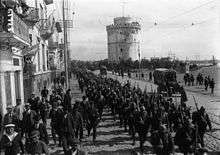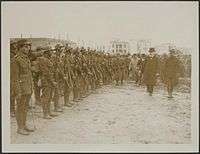National Defence Army Corps
| National Defence Army Corps | |
|---|---|
| Active | 1916/17–1920 |
| Country | Greece |
| Allegiance | Provisional Government of National Defence (1916/17), Greece (1917/20), and Allies of World War I |



The Army of National Defence (Greek: Στρατός Εθνικής Αμύνης) was the military force of the Provisional Government of National Defence, a pro-Allied government led by Eleftherios Venizelos in Thessaloniki in 1916–17, against the royal government of King Constantine I in Athens, during the so-called National Schism. By the spring of 1917, three infantry divisions formed the National Defence Army Corps (Σώμα Στρατού Εθνικής Αμύνης). Following the ousting of King Constantine and the reunification of Greece under the leadership of Venizelos in June 1917, the Corps continued as part of the reconstituted Hellenic Army until 1920, when it became the Army of Thrace.
Background
The question of Greece's participation in World War I had led to acute political divisions, with the pro-Allied Prime Minister Eleftherios Venizelos opposed by the pro-German King Constantine I, who favoured neutrality. This led to Venizelos' resignation, and the establishment of a series of royalist governments in Athens. In the meantime, however, the Allies had landed at Thessaloniki to aid Serbia, and Greece found herself threatened by both the Allies and the Central Powers. On 5 August 1916[1], the Bulgarian invasion of eastern Macedonia commenced, facing little resistance, since the Athens government refused to condone any firm action. The surrender of the hard-won territories gained in the recent Balkan Wars led to a military mutiny in Thessaloniki on 17 August. The mutiny, conducted in the name of "National Defence", led by pro-Venizelos officers like Leonidas Paraskevopoulos, Konstantinos Mazarakis-Ainian, or Epameinondas Zymvrakakis, was supported by the Allied commander-in-chief, Maurice Sarrail, and quickly established control over the city against loyalist officers.
Venizelos himself with his closest aides left Athens on 12 September, initially for his home island of Crete, and from there via Chios and Lesbos to Thessaloniki, where he arrived on 24 September. Four days later, on 28 September, he formed a provisional government under the supreme leadership of a triumvirate comprising himself, General Panagiotis Danglis and Admiral Pavlos Koundouriotis (the "Triumvirate of National Defence", Τριανδρία της Εθνικής Αμύνης).[2]
World War I
As soon as the revolt was successfully established, individual officers from across northern Greece began to flock to Thessaloniki. On 2 September, the "National Defence" received its first substantial reinforcement, as Colonel Nikolaos Christodoulou arrived in the city with the remnants of units of the IV Army Corps that had refused to surrender to the Bulgarians and instead withdrawn via Kavala and Samothrace. Already on 8 September, the volunteers under Major Neokosmos Grigoriadis formed the 1st Battalion of the "Army of National Defence", and departed for the front lines along the Strymon river.[2]
The new government began forming the remnants of various forces in northern Greece, as well as volunteers from Crete and the Aegean islands, which it controlled, into a fighting force. The Serres Division (Μεραρχία Σερρών) was the first major formation to be established in September–November 1916, comprising the 1st Serres Regiment from elements of the 17th Infantry Regiment and the 2/21 Cretan Regiment, the 2nd Serres Regiment from the 18th Infantry Regiment and volunteers, and the 3rd Serres Regiment from elements of the 2/21 Cretan Regiment, as well as volunteers from Crete and Asia Minor. It was followed by the Archipelago Division (Μεραρχία Αρχιπελάγους) in September1916 – March 1917, comprising the 4th Archipelago Regiment at Chios, the 5th Archipelago Regiment at Lesbos, and the 6th Archipelago Regiment at Samos. The Crete Division (Μεραρχία Κρήτης) was formed in October 1916 – May 1917, with its nucleus being the 1/14 Cretan Regiment at Chania, which became the 7th Cretan Regiment. The 8th Cretan Regiment at Rethymno, and the 9th Cretan Regiment at Heraklion, followed.
The effort to raise an army was hampered by lack of equipment and supplies, royalist opposition, as well as the general reluctance of the populace to become involved in a war that they cared little about, especially following the recent Balkan Wars. Nevertheless, by spring 1917 the "National Defence" had brought her three divisions to the Macedonian Front, and formed the National Defence Army Corps under Emmanouil Zymvrakakis. The victorious Battle of Skra-di-Legen in May 1917 served as the baptism of fire for the Army of National Defence. A month later, King Constantine I was forced to abdicate by the Allies, and was succeeded by his second son, Alexander. Venizelos returned to Athens as Prime Minister and virtual dictator.
With Venizelos back in power, the reconstitution of the Hellenic Army began, a long and arduous process. In the meantime, the three extant divisions were employed under Allied command, and were usually combined with other Allied forces. The Greek GHQ planned the creation of three army corps, i.e., the reconstituted I and II Corps, and the "National Defence Army Corps", but delays in the reconstitution of the Greek army meant that Greece could not claim a decisive voice in the conduct of operations; the "National Defence Army Corps" continued to exit, but most Greek divisions continued to serve under Allied commanders for much of the duration of the war.
Operations in Western Thrace
After the Armistice of November 1918, the National Defence Army Corps remained in Macedonia. In early 1919, the Crete and Archipelago divisions were sent to Asia Minor, where the Asia Minor Campaign began; the Corps was reinforced with the reconstituted 9th Infantry Division. As part of the Allied occupation of Western Thrace, which had belonged to Bulgaria following the Balkan Wars, on 16 October 1919 the Corps occupied Xanthi, where the Xanthi Division was raised. In May 1920, subsequent to the Treaty of Neuilly-sur-Seine, the Serres Division occupied Komotini and the Xanthi Division and 9th Division occupied the modern Evros Prefecture. On 3 June 1920, it was renamed as the Army of Thrace.
References
- ↑ Note: Greece officially adopted the Gregorian calendar on 16 February 1923 (which became 1 March). All dates prior to that, unless specifically denoted, are Old Style.
- 1 2 Μεγάλη Στρατιωτική και Ναυτική Εγκυκλοπαιδεία. Τόμος Γ′: Δαβατηνός – Ιωσήφ [Great Military and Naval Encyclopedia. Volume III] (in Greek). Athens. 1929. pp. 496–497.